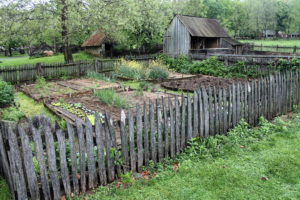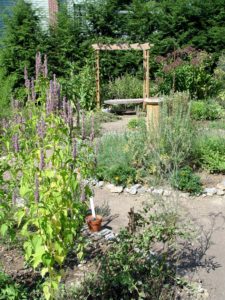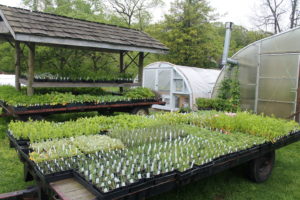How Our Fore-Gardeners Gardened
May 9th, 2017
Lancaster County’s Landis Valley Village and Farm Museum is one of those attractions we tend to overlook because it’s so close to our own back yard.
A lot of locals have never seen it, and many more have been there once – maybe on a fifth-grade elementary-school field trip.
But this bucolic 100 acres off the Oregon Pike is a fascinating living-history museum, kind of like the Colonial Williamsburg of Pennsylvania German settlers.
It has authentic and recreated buildings from the 1800s and early 1900s, demonstrations of what our region’s early settlers did from day to day, and thousands of farm and household items from that time period.
For gardeners, Landis Valley’s fields, gardens and plants give a hands-on look at how our “fore-gardeners” gardened – especially when it comes to feeding themselves in the days before Giant, Weis, Karns and Wegman’s.
Much of our central-Pennsylvania collective personality even today has inklings that trace to the Pennsylvania Germans, also known as the “Pennsylvania Dutch” because English settlers butchered the pronunciation of “Deutsch” (German for German).
The first Germans made their way to Philadelphia in 1683 and soon were swarming by the shipload because of the promise of religious freedom and the superb farmland and countryside that reminded them of Germany.
By 1700, many of them were moving into the “western wilderness” of Lancaster County, which had even better farm soil than the Philadelphia area.
One interesting guide these early settlers used to gauge good soil… walnut trees. When they saw a healthy stand of native walnuts, they knew the base was limestone and therefore a good place to till and plant.
These people were clever and hard-working, although they at first kept to themselves and purposely hung on to their language and culture. About 90 percent of them (at least originally) were farmers.
You’ll see some of the field crops (grain, corn, pumpkins, squash, potatoes, etc.) that the settlers grew in Landis Valley’s demo field.
But even more fascinating – if you’re a gardener – are the smaller gardens that show how the Pennsylvania Germans planted their plots and what they planted in them.
Back then, your garden was your source not just for meals but also for medicines, dyes, insect repellents, clothing and so much else around the house that we now just go out and buy.
Landis Valley’s herb demonstration garden focuses on 18th and 19th century plants (primarily herbs) that were used for everyday items.
Examples: soapwort was grown for its sudsy properties that helped clean clothes; lavender, mints and rosemary were added to wash water to give clothes a pleasant fragrance; flax was grown for its linen fibers, and assorted plants were used to dye clothes (goldenrod for yellow, beets for red, yellow iris roots for black, etc.)
What I find most fascinating, though, is the way the Pennsylvania Germans grew their edibles.
The system of choice was a “four-square garden,” so named because the large square or rectangular gardens were broken into four same-sized quadrants within a large picket fence.
The fences were made by hammering posts 11 feet apart, connecting them with 12-foot rails, then nailing 3-foot-tall flat, hardwood pickets upright to the rails. The idea was to keep out the many pests that we still battle today.
The gardens themselves were usually sized in 11-foot increments because of the fence size. A common four-square garden was either 55 or 66 feet long and wide.
The beds inside were raised about 6 inches and lined with boards to retain the soil. Paths were usually left in dirt, and more boards were laid flat in the four plots to walk on so as not to overly compact the soil or accidentally step on plantings.
Many of the gardens had a centerpiece plant as well. Yucca was the species of choice.
This system makes so much sense that it’s the one I use in my own back yard. Mine is much smaller and has a wire fence rather than wooden pickets, but it’s laid out in four quadrants of raised beds with a center circle planted with a big, bold rhubarb plant (a Pennsylvania German favorite, by the way) and an edging of oregano.
At Landis Valley, the heritage gardens are planted with varieties that the early Pennsylvania Germans grew. Some of them were originally brought from Germany, and many others are ones that have been handed down from generation to generation by ancestors of 18th– and 19th-century German settlers.
The staff grows these heirloom varieties and saves them for sale to gardeners interested in trying these old-time favorites.
For the past 30 years, Landis Valley’s Heirloom Seed Project has been selling hundreds of heirloom varieties through a catalog as well as at its museum store and at its annual Herb and Garden Faire.
The Herb and Garden Faire is coming up this weekend – Fri., May 12, and Sat., May 13, 2017 – from 9 a.m. to 5 p.m. on the Landis Valley grounds at 2451 Kissel Hill Road, Lancaster.
In addition to heirloom seeds, Landis Valley grows about 10,000 heirloom plants that are sold over the two days along with all sorts of plants and gardening items sold by 80 area vendors. It’s become the museum’s biggest event, drawing lines to get in first thing on Friday.
If you’re an heirloom fan, Landis Valley is particularly strong on heirloom tomato and bean varieties.
Most famous is the ‘Brandywine’ tomato that wins many tomato-tasting contests. But also well worth growing is the ‘German Strawberry’ tomato (a red meaty variety shaped like a big strawberry), the ‘Amish Paste’ tomato (a big and tasty Roma type), and the ‘Cherokee Purple’ tomato (a mid-sized type with dark flesh).
Some other curious choices that the early Germans grew – and living on in the Heirloom Seed Project collection – is the ‘Munchener Bier’ radish (usually eaten with beer), the ‘Pretzel’ bean (a pole bean with long twisty pods), ‘Amish Deer Tongue’ lettuce (a heat-tolerant lettuce with blade-like leaves), and the ‘Lutz’ beet (one of the biggest beets you’ll ever grow).
The Herb and Garden Faire would be a good time to visit if you’re a gardener. The fall Harvest Days festival, scheduled this year for Oct. 7 and 8, would be another good time when harvest-related demos take place and vendors are back.
Lots of other special events and classes take place at other times throughout the year. The schedule is on Landis Valley’s online calendar.
Otherwise, the museum is open between now and the end of the year Tuesdays through Saturdays from 9 a.m. to 5 p.m. and Sundays from noon to 5 p.m. It’s closed Mondays and nine holidays.
Admission is $12 for adults, $10 for ages 65 and up, and $8 for ages 3-11.











